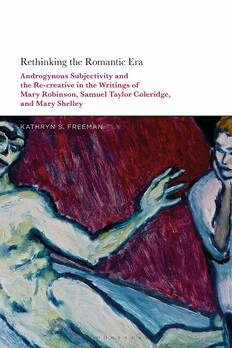
Rethinking the Romantic Era: Androgynous Subjectivity and the Recreative in the Writings of Mary Robinson, Samuel Taylor Coleridge, and Mary Shelley PDF
Preview Rethinking the Romantic Era: Androgynous Subjectivity and the Recreative in the Writings of Mary Robinson, Samuel Taylor Coleridge, and Mary Shelley
Rethinking the Romantic Era ii Rethinking the Romantic Era Androgynous Subjectivity and the Recreative in the Writings of Mary Robinson, Samuel Taylor Coleridge, and Mary Shelley Kathryn S. Freeman BLOOMSBURY ACADEMIC Bloomsbury Publishing Plc 50 Bedford Square, London, WC1B 3DP, UK 1385 Broadway, New York, NY 10018, USA BLOOMSBURY, BLOOMSBURY ACADEMIC and the Diana logo are trademarks of Bloomsbury Publishing Plc First published in Great Britain 2021 Copyright © Kathryn S. Freeman, 2021 Kathryn S. Freeman has asserted her right under the Copyright, Designs and Patents Act, 1988, to be identified as Author of this work. For legal purposes the Acknowledgments on p. ix constitute an extension of this copyright page. Cover design: Eleanor Rose Cover image © Jane Freeman All rights reserved. No part of this publication may be reproduced or transmitted in any form or by any means, electronic or mechanical, including photocopying, recording, or any information storage or retrieval system, without prior permission in writing from the publishers. Bloomsbury Publishing Plc does not have any control over, or responsibility for, any third-party websites referred to or in this book. All internet addresses given in this book were correct at the time of going to press. The author and publisher regret any inconvenience caused if addresses have changed or sites have ceased to exist, but can accept no responsibility for any such changes. A catalogue record for this book is available from the British Library. A catalog record for this book is available from the Library of Congress. ISBN: HB: 978-1-3501-6740-7 ePDF: 978-1-3501-6743-8 eBook: 978-1-3501-6742-1 Typeset by Newgen KnowledgeWorks Pvt. Ltd., Chennai, India To find out more about our authors and books visit www.bloomsbury.com and sign up for our newsletters. This book is dedicated to my son, Jordan, and my sisters, Jane, Linda, and Elizabeth, all of whom inspire me with their gifts and their commitment to their own recreative art. vi Contents Acknowledgments ix List of Abbreviations x Note on the Text xi Introduction: Androgynous Subjectivity and the Recreative 1 Coleridge Writing Wordsworth, Reading Wordsworth: A Reappraisal 7 Spheres of Mutual Influence 9 Gender as Nexus: Reintegrating the Poetic and Epistemological 12 Reappraising Influence: Coleridge, Robinson, and Shelley 21 1 Coleridge’s Gendered Revolt against Materialism: Textual Plasticity in “The Eolian Harp,” Rime of the Ancient Mariner, and “Kubla Khan” 27 Dilation and Contraction in “The Eolian Harp” 30 Androgyny and Recreation in “Kubla Khan” 38 Subverting Moral Binaries: Biographia Literaria and Rime of the Ancient Mariner 46 2 Coleridge and Robinson: “Sense Unchained” 57 Dismantling Gender Binaries: “The Maniac,” “Kubla Khan,” and “To Coleridge” 60 The Conversation between Robinson and Coleridge in Walsingham: Androgyny, Subjectivity, and the Perverse 68 Coleridge after Robinson: The Paradox of Mourning Fellowship Founded on Nondualism 83 3 Secondary Imagination, Contamination, and Androgyny: Rethinking Coleridgean Fragmentation from “Kubla Khan” and Christabel to Magnum Opus 87 Christabel: Subverting Masculinist Subjectivity 89 Dejection’s Layering Fragments of Selfhood 99 viii Contents Dismantling Dualistic Systems of Morality in Order to Recreate: German Philosophy, Biographia Literaria, and the “Positive Negation” of Magnum Opus 102 4 The Plague of Storytelling: Mary Shelley through the Lens of Robinson and Coleridge 113 Undercutting Masculine Subjectivity: Walsingham and Frankenstein 116 Contamination and the Subversion of the Moral Tale: Frankenstein and Rime of the Ancient Mariner 121 Daughters, Fathers, and Recreated Mothers: Mathilda and Christabel 128 Narrative Contamination and Gender in The Last Man: Plague as “Queen of the World” 136 Coda 147 Selected Bibliography 149 Index 159 Acknowledgments I am grateful for the many forms of support that helped me shape this book. For the opportunity to hone this project at its earliest phase through a research fellowship, I thank the University of Miami Center for Humanities. Two conferences, the 2016 BSESC Conference at Oxford and the 2018 Coleridge Conference at Cambridge, were invaluable in allowing me to present different phases of the project to colleagues in the field; for helping provide financial support to attend these meetings and for time to write and perform research, I am grateful to the University of Miami’s College of Arts and Sciences and the Department of English. I thank Elizabeth Denlinger, curator of the New York Public Library’s Pforzheimer Collection of Shelley and His Circle, who provided both her expertise and access to original manuscripts by Mary Robinson and Mary Shelley. For their scholarly insights, suggestions, and encouragement I thank Grevel Lindop, Stephen Berendt, and Frederick Burwick. For meticulous editing and timely production, especially during the Coronavirus pandemic, I thank everyone at Bloomsbury involved with the project. I am grateful to the art department for using as the cover image the painting from the Frankenstein series by my sister, Jane Freeman. As always, I thank my students for providing fresh perspectives and questions that have continued to motivate and challenge me.
